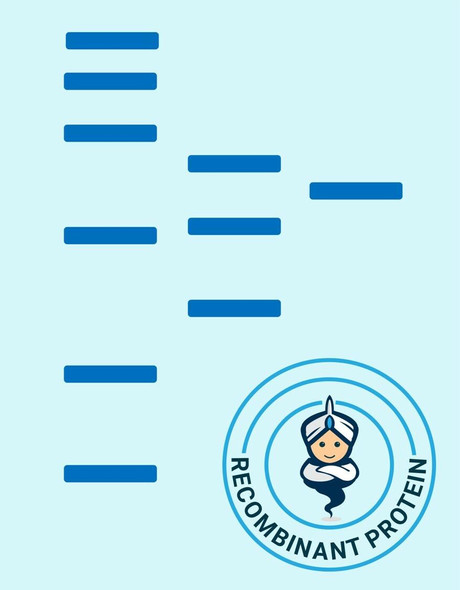Growth Factors & Cytokines Recombinant Proteins
Human SCF Recombinant Protein (RPPB0950)
- SKU:
- RPPB0950
- Product Type:
- Recombinant Protein
- Species:
- Human
- Uniprot:
- P21583
- Research Area:
- Growth Factors & Cytokines
Description
| Product Name: | Human SCF Recombinant Protein |
| Product Code: | RPPB0950 |
| Size: | 10µg |
| Species: | Human |
| Target: | SCF |
| Synonyms: | Kit ligand Precursor, C-kit ligand, SCF, Mast cell growth factor, MGF, SF, KL-1, Kitl, DKFZp686F2250. |
| Source: | HEK293 Cells |
| Physical Appearance: | Sterile Filtered White lyophilized (freeze-dried) powder. |
| Formulation: | SCF was lyophilized from a 0.2�m filtered solution (1mg/ml) containing 1xPBS. |
| Solubility: | It is recommended to reconstitute the lyophilized SCF in sterile PBS containing 0.1% endotoxin-free recombinant HSA. |
| Stability: | Lyophilized SCF although stable at room temperature for 3 weeks, should be stored desiccated below -18°C. Upon reconstitution SCF should be stored at 4°C between 2-7 days and for future use below -18°C.For long term storage it is recommended to add a carrier protein (0.1% HSA or BSA).Please prevent freeze-thaw cycles. |
| Purity: | Greater than 95% as obsereved by SDS-PAGE. |
| Biological Activity: | The specific activity was determined by the dose-dependent stimulation of the proliferation of human TF-1 cells (human erythroleukemic indicator cell line). The EC50 is 15.25ng/ml. |
Stem cell factor / KIT ligand (SCF) is a cytokine which binds CD117(c-Kit). SCF is also known as "steel factor" or "c-kit ligand". SCF exists in two forms, cell surface bound SCF and soluble (or free) SCF. Soluble SCF is produced by the cleavage of surface bound SCF by metalloproteases. SCF is a growth factor important for the survival, proliferation, and differentiation of hematopoietic stem cells and other hematopoietic progenitor cells. One of its roles is to change the BFU-E (burst-forming unit-erythroid) cells, which are the earliest erythrocyte precursors in the erythrocytic series, into the CFU-E (colony-forming unit-erythroid).
SCF Human Recombinant produced in HEK cells is a glycosylated monomer, having a molecular weight range of 35-45kDa due to glycosylation.The SCF is purified by proprietary chromatographic techniques.
| UniProt Protein Function: | SCF: Ligand for the receptor-type protein-tyrosine kinase KIT. Plays an essential role in the regulation of cell survival and proliferation, hematopoiesis, stem cell maintenance, gametogenesis, mast cell development, migration and function, and in melanogenesis. KITLG/SCF binding can activate several signaling pathways. Promotes phosphorylation of PIK3R1, the regulatory subunit of phosphatidylinositol 3-kinase, and subsequent activation of the kinase AKT1. KITLG/SCF and KIT also transmit signals via GRB2 and activation of RAS, RAF1 and the MAP kinases MAPK1/ERK2 and/or MAPK3/ERK1. KITLG/SCF and KIT promote activation of STAT family members STAT1, STAT3 and STAT5. KITLG/SCF and KIT promote activation of PLCG1, leading to the production of the cellular signaling molecules diacylglycerol and inositol 1,4,5- trisphosphate. KITLG/SCF acts synergistically with other cytokines, probably interleukins. Homodimer, non-covalently linked (Probable). Heterotetramer with KIT, binding two KIT molecules; thereby mediates KIT dimerization and subsequent activation by autophosphorylation. Belongs to the SCF family. 3 isoforms of the human protein are produced by alternative splicing. |
| UniProt Protein Details: | Protein type:Membrane protein, integral Chromosomal Location of Human Ortholog: 12q22 Cellular Component: extracellular space; cytoskeleton; cytoplasm; integral to membrane; extracellular region; plasma membrane Molecular Function:protein binding; growth factor activity; cytokine activity; stem cell factor receptor binding Biological Process: epidermal growth factor receptor signaling pathway; fibroblast growth factor receptor signaling pathway; phosphoinositide-mediated signaling; nerve growth factor receptor signaling pathway; embryonic hemopoiesis; male gonad development; germ cell programmed cell death; signal transduction; positive regulation of MAP kinase activity; cell proliferation; positive regulation of peptidyl-tyrosine phosphorylation; negative regulation of mast cell apoptosis; positive regulation of melanocyte differentiation; innate immune response; positive regulation of Ras protein signal transduction; positive regulation of myeloid leukocyte differentiation; cell adhesion; neural crest cell migration; positive regulation of DNA replication Disease: Hyperpigmentation, Familial Progressive, 2; Skin/hair/eye Pigmentation, Variation In, 7 |
| NCBI Summary: | This gene encodes the ligand of the tyrosine-kinase receptor encoded by the KIT locus. This ligand is a pleiotropic factor that acts in utero in germ cell and neural cell development, and hematopoiesis, all believed to reflect a role in cell migration. In adults, it functions pleiotropically, while mostly noted for its continued requirement in hematopoiesis. Two transcript variants encoding different isoforms have been found for this gene. [provided by RefSeq, Jul 2008] |
| UniProt Code: | P21583 |
| NCBI GenInfo Identifier: | 134289 |
| NCBI Gene ID: | 4254 |
| NCBI Accession: | P21583.1 |
| UniProt Secondary Accession: | P21583,Q16487, Q68DZ2, Q7M4N8, Q9UQK7, A0AV09, A8K2Q4 B7ZLM4, |
| UniProt Related Accession: | P21583 |
| Molecular Weight: | Approximately 150 kDa |
| NCBI Full Name: | Kit ligand |
| NCBI Synonym Full Names: | KIT ligand |
| NCBI Official Symbol: | KITLG�� |
| NCBI Official Synonym Symbols: | SF; MGF; SCF; FPH2; KL-1; Kitl; SHEP7�� |
| NCBI Protein Information: | kit ligand; c-Kit ligand; steel factor; stem cell factor; mast cell growth factor; familial progressive hyperpigmentation 2 |
| UniProt Protein Name: | Kit ligand |
| UniProt Synonym Protein Names: | Mast cell growth factor; MGF; Stem cell factor; SCF; c-Kit ligandCleaved into the following chain:Soluble KIT ligand; sKITLG |
| Protein Family: | SCF-associated factor |
| UniProt Gene Name: | KITLG�� |
| UniProt Entry Name: | SCF_HUMAN |






